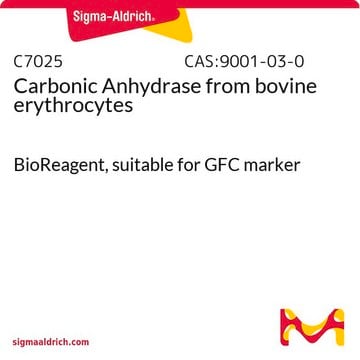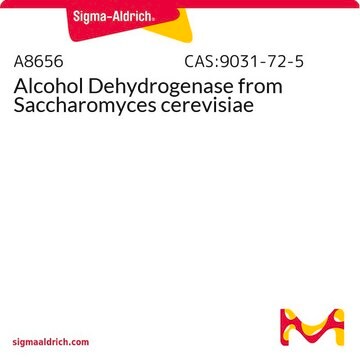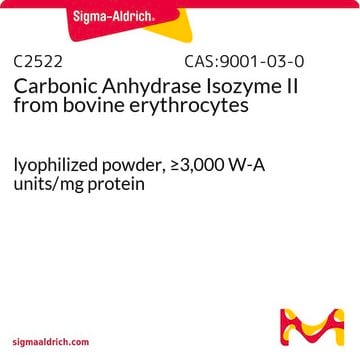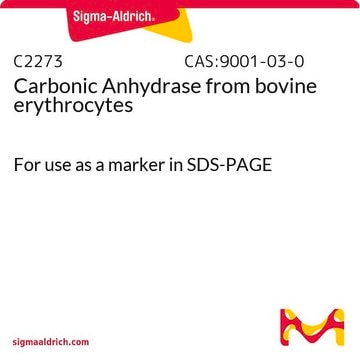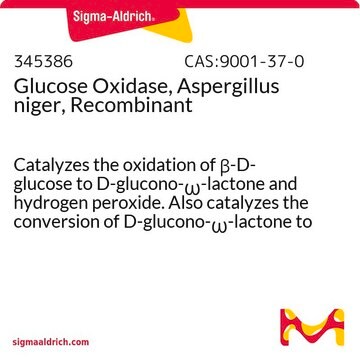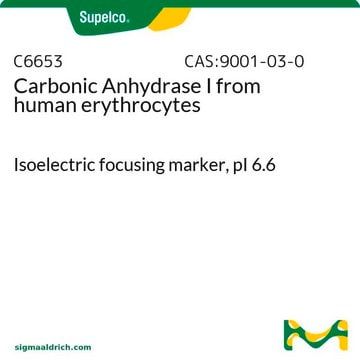The activity of this enzyme is established using a 0.02 M Tris buffer with a starting pH of 8.3 at 0°C. One unit will cause the pH of a 0.02 M Trizma buffer to drop from 8.3 to 6.3 per min at 0°C. However, the optimum pH and temperature is highly dependent on the specific application. There are a number of publications regarding the working parameters for this material. Please see the link below to review an example:
https://pubmed.ncbi.nlm.nih.gov/10701452/#:~:text=It%20was%20determined%20that%20the,61706%20Dalton%20by%20gel%20filtration.
C2624
Carbonic Anhydrase from bovine erythrocytes
≥95% (SDS-PAGE), specific activity ≥3,500 W-A units/mg protein, lyophilized powder
동의어(들):
Carbonic Anhydrase from bovine erythrocytes, Carbonate Dehydratase, Carbonate Hydrolyase
크기 선택
About This Item
추천 제품
생물학적 소스
bovine erythrocytes
분석
≥75% protein basis (biuret)
≥95% (SDS-PAGE)
양식
lyophilized powder
특이 활성도
≥3,500 W-A units/mg protein
solubility
deionized water: >10 mg/mL
저장 온도
2-8°C
유사한 제품을 찾으십니까? 방문 제품 비교 안내
애플리케이션
생화학적/생리학적 작용
단위 정의
신호어
Danger
유해 및 위험 성명서
예방조치 성명서
Hazard Classifications
Resp. Sens. 1
Storage Class Code
11 - Combustible Solids
WGK
WGK 3
Flash Point (°F)
Not applicable
Flash Point (°C)
Not applicable
가장 최신 버전 중 하나를 선택하세요:
시험 성적서(COA)
이미 열람한 고객
-
What is recommand usage temperature and pH range?
1 답변-
도움이 되었습니까?
-
-
What is the recommended storage conditions for "Carbonic Anhydrase, from bovine erythrocytes?
1 답변-
The recommended storage conditions for Solution of Carbonic Anhydrase, from bovine erythrocytes may be frozen at –20 °C for future use. It is advised to avoid repeated freezing and thawing. Stock solutions may be dispensed into working aliquots, frozen, and then discarded after 2–3 uses.
도움이 되었습니까?
-
-
What is the isozyme I or isozyme II of Carbonic Anhydrase from bovine erythrocytes (C2624 Carbonic Anhydrase)?
1 답변-
The product C2624, Carbonic Anhydrase from bovine erythrocytes, consists mainly of CA II. However, there are also small levels of CA I and CA IV present.
도움이 되었습니까?
-
-
Is it possible to obtain information about the type of Carbonic Anhydrase (I or II) included in item C2624-carbonic anhydrase?
1 답변-
Product C2624, Carbonic Anhydrase from bovine erythrocytes, with a purity of ≥95% (SDS-PAGE), consists predominantly of CA II, with small levels of CA I and CA IV present.
도움이 되었습니까?
-
활성 필터
자사의 과학자팀은 생명 과학, 재료 과학, 화학 합성, 크로마토그래피, 분석 및 기타 많은 영역을 포함한 모든 과학 분야에 경험이 있습니다..
고객지원팀으로 연락바랍니다.
